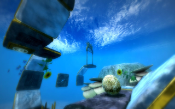Puzzle Dimension Review
|
|
See PixlBit's Review Policies

On 09/21/2010 at 11:06 PM by Nick DiMola This budget-priced puzzle game delivers an engaging and thoughtful experience. |

At $9.99 all fans of puzzle games should grab this title.
Kororinpa. That's what I first thought when I saw Puzzle Dimension. I was most definitely mistaken, as Puzzle Dimension is nothing like the Wii marble rolling game. Instead, Puzzle Dimension is a pure puzzle game that requires players to make calculated movements and jumps to first collect the flowers in a level and then make their way back to the exit.

While this goal sounds easy enough, it becomes less and less simple as more hazards are added to the levels. Like most puzzle games, things start off quite simple in Puzzle Dimension; players need only to avoid traversing crumbling floor panels and ice panels, which perpetuate ball movement.
During the first few levels, players will learn the basics of the game. Movement is handled with the directional pad on the keyboard, with the simple premise that one key press translates to moving one panel in the level. Jumping can be performed simultaneously in order to avoid certain panels on the level, whether they be a hazard or just a hole.

While players traverse the board collecting flowers, which there are usually three of in the beginning, they are de-pixelizing the panel they land on and the panels around them. Each panel on the board that is de-pixelized will raise a constantly decreasing meter for point multiplication. Once it reaches a certain threshold, the multiplier will not decrease, which in turn pushes players to reach enough new panels quickly enough to get the largest multiplier possible. Completing the level after de-pixelating all of the panels provides a point bonus and will mark players off with 100% level completion.
As players push further into the game a variety of other hazards are introduced, as are some other concepts. Some examples include bounce platforms that shoot players two panels forward in the direction they are moving, grills that light up after first touch, and switches that will toggle appearance of two sets of panels as well as others which toggle spiked panels. In addition to this sampling of hazards, players will start dealing with puzzles in three dimensions.

The three dimensional puzzles are particularly interesting, as they force players to consider how to get around to all parts of the board, which often requires complicated movement using the third dimension. In order to execute the concept, gravity shifts with the player. Thus when players have navigated floor panels and find themselves upside-down from where they started, rolling off the board will cause them to fall into what was once the sky. Given this different concept of gravity, a number of puzzles force players to roll off the board and catch different platforms that are gravitationally below them.
It's hard to demonstrate exactly what's so great about Puzzle Dimension by describing what's in the game. These set pieces have essentially allowed Doctor Entertainment to craft some ingenious levels that require players to try many different solutions in order to figure it all out. A mere thirty levels into the game's 100 I found myself running into puzzles that burned all bridges back to the exit after collecting the flowers in the level. When I reached that dead end, it was obvious that the designers had purposely walked me down the road I went because it "seemed" like the right solution. While I thought I was close to the answer, I actually had to chart out an entirely new route to solve the puzzle and make it to the exit.

This does lead to an eventual shortcoming of the game. As players push further and further into the game, the levels become grander and grander in scope, making it much harder to plot out a path through the whole level. This forces players to solve the puzzle similarly to how a computer would do it: by brute force. If a computer were trying to solve the level, it would take a path until it hit a dead end, try it again in a slightly different way until it exhausted all possibilities, and then start on a new path all together. This is exactly what players must do as it becomes impossible to think out enough steps in order to make it all the way through the level just by looking at the board.
This shift in approach to solving levels ultimately changes the pacing of the game, creating a less enjoyable and thought-demanding experience. While this plodding nature can be frustrating, it's still worth commending the developers for crafting some amazingly deep levels that require exceptional mastery for the majority of the game.

Worth mentioning briefly is both the sound and graphical design of the game. While the presentation is quite simple, the game looks very pretty in motion, and the soft blur applied to the world is easy on the eyes. De-pixelating a panel looks fantastic and is a much more appealing way to show that a given panel has been activated. As a bonus, players will unlock new themes which can give the game a totally different look. The retro-themed in-game music is also impressively done, proving to be quite catchy while playing the game.
Those with access to Steam on either PC or Mac should absolutely give Puzzle Dimension a shot. It's a fulfilling indie puzzle game, and while it does become a bit frustrating towards the end, it's a great time while it lasts.










Comments